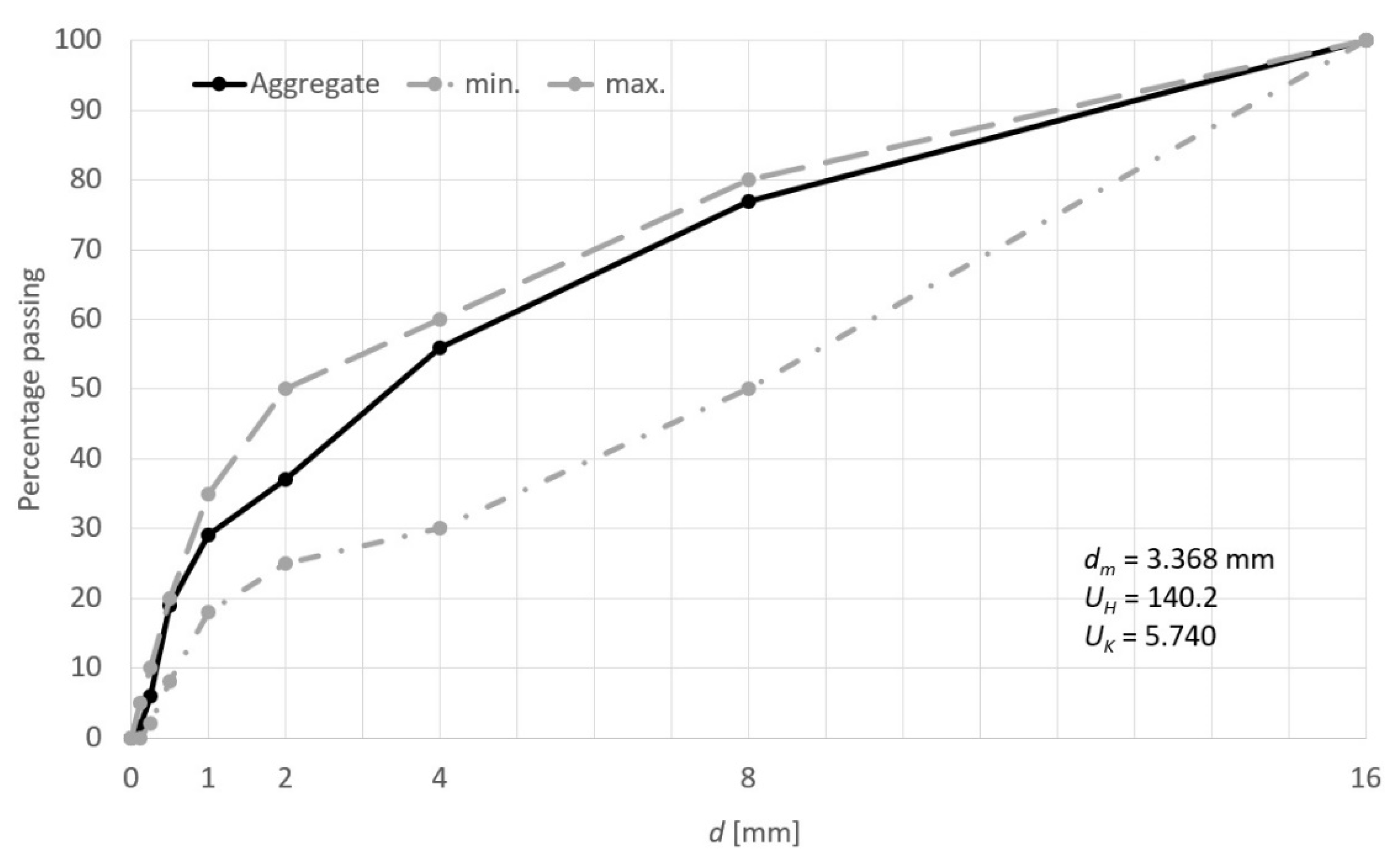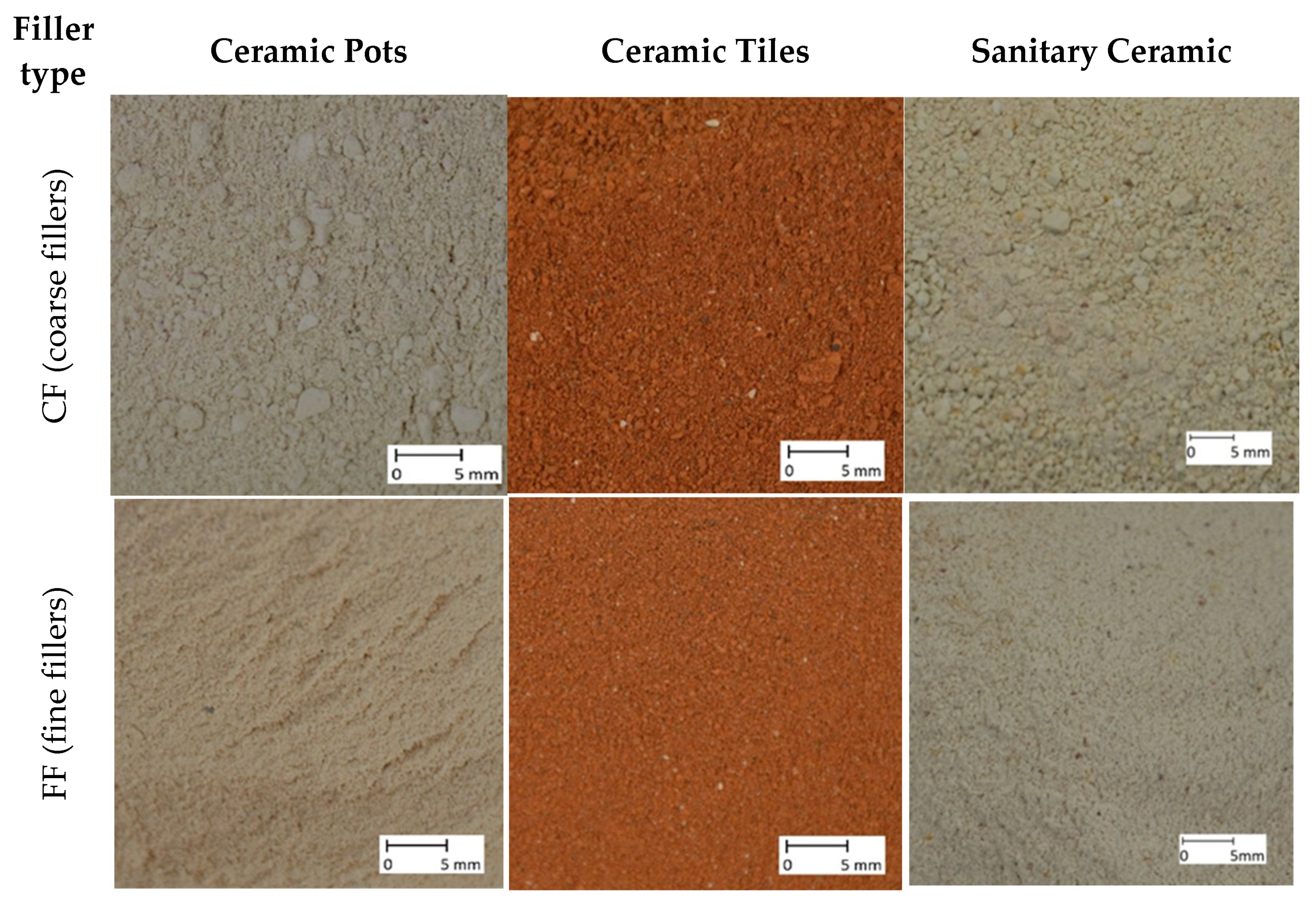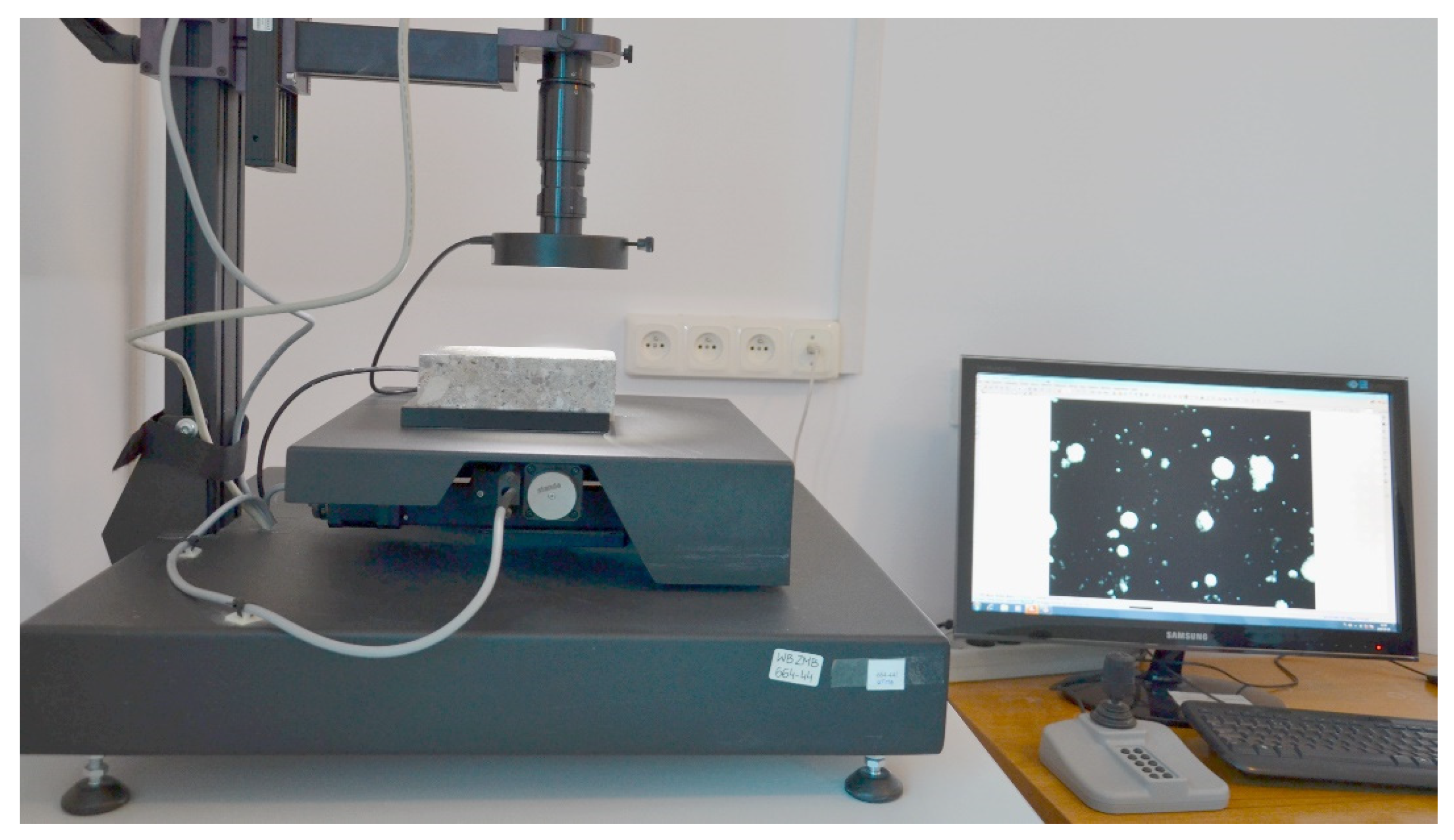Influence of Varied Waste Ceramic Fillers on the Resistance of Concrete to Freeze–Thaw Cycles
Abstract
:1. Introduction
2. Materials
3. Research Program
4. Results
5. Discussion
6. Conclusions
- The effect of the addition of ceramic fillers (both fine and coarse) on the compressive strength was negligible.
- The addition of ceramic fillers increased the aeration of concrete.
- Concretes with ceramic fillers were characterized by higher contents of micro–pores in class 18 (with a diameter of up to 300 µm) in comparison to the reference concrete.
- The content of micro–pores directly influenced the resistance of the tested concretes to freeze–thaw cycles.
- The best effect on the resistance to freeze–thaw cycles was achieved by the addition of all three fine fillers that were considered in this study.
- Additional tests should be conducted using different ceramic fillers to confirm the achieved results.
- The possibility of reactions between the fillers and cement paste should be investigated in the future.
Author Contributions
Funding
Data Availability Statement
Conflicts of Interest
References
- Tang, Z.; Li, W.; Tam, V.W.Y.; Xue, C. Advanced progress in recycling municipal and construction solid wastes for manufacturing sustainable construction materials. Resour. Conserv. Recycl. X 2020, 6, 100036. [Google Scholar] [CrossRef]
- Elçi, H. Utilisation of crushed floor and wall tile wastes as aggregate in concrete production. J. Clean. Prod. 2016, 112, 742–752. [Google Scholar] [CrossRef]
- Guerra, I.; Vivar, I.; Liamas, B.; Juan, A.; Moran, J. Eco–efficient concretes: The effect of using recycled ceramic material from sanitary installations on the mechanical properties of concrete. Waste Manag. 2009, 29, 643–646. [Google Scholar] [CrossRef] [PubMed]
- Martinez, M.; Romero, G.; Morán del Pozo, J.M.; Valdés, A.J. Use of ceramics wastes in structural concretes. In In Proceedings of the 1 st Spanish National Conference on Advances in Material Recycling and Eco—Energy, Madrid, Spain, 12–13 November 2009. [Google Scholar]
- Medina, C.; Frías, M.; Sánchez de Rojas, M.I. Microstructure and properties of recycled concretes using ceramic sanitary ware industry waste as coarse aggregate. Constr. Build. Mater. 2012, 31, 112–118. [Google Scholar] [CrossRef]
- Senthamarai, R.M.; Devadas Manoharan, P. Concrete with ceramic waste aggregate. Cement Concrete Comp. 2005, 27, 910–913. [Google Scholar] [CrossRef]
- Higashiyamaa, H.; Yagishitaa, F.; Sanoa, M.; Takahashib, O. Compressive strength and resistance to chloride penetration of mortars using ceramic waste as fine aggregate. Constr. Build. Mater. 2012, 26, 96–101. [Google Scholar] [CrossRef]
- Rubio de Hitaa, P.; Pérez–Gálveza, F.; Morales–Condeb, M.J.; Pedreño–Rojasa, M.A. Characterisation of recycled ceramic mortars for use in prefabricated beam–filling pieces in structural floors. Mater. Construcc. 2019, 69. [Google Scholar] [CrossRef]
- Andrzejuk, W.; Szewczak, A.; Fic, S.; Grzegorz Łagód, G. Wettability of Asphalt Concrete with Natural and Recycled Aggregates from Sanitary Ceramics. Materials 2020, 13, 3799. [Google Scholar] [CrossRef]
- Farinha, C.; de Brito, J.; Veiga, R. Incorporation of fine sanitary ware aggregates in coating mortars. Constr. Build. Mater. 2015, 83, 194–206. [Google Scholar] [CrossRef]
- Ruiz, L.A.L.; Ramón, X.R.; Domingo, S.G. The circular economy in the construction and demolition waste sector—A review and an integrative model approach. J. Clean. Prod. 2020, 248, 119238. [Google Scholar] [CrossRef]
- Basuyau, V. Construction and demolition waste recycling in Europe: Long–term trends and challenges ahead. Indian Concr. J. 2020, 94, 8–18. [Google Scholar]
- dos Reis, G.S.; Cazacliu, B.G.; Cothenet, A.; Poullain, P.; Wilhelm, M.; Sampaio, C.H.; Lima, E.C.; Ambros, W.; Torrenti, J.M. Fabrication, microstructure, and properties of fired clay bricks using construction and demolition waste sludge as the main additive. J. Clean. Prod. 2020, 258, 120733. [Google Scholar] [CrossRef]
- El–Dieb, A.S.; Kanaan, D.M. Ceramic waste powder an alternative cement replacement—Characterization and evaluation. Sustain. Mater. Technol. 2018, 17, e00063. [Google Scholar] [CrossRef]
- Zegardło, B. Recycling of electrical insulators, by their secondary use, as substitutes for mineral aggregates in artificial composites based on orthophthalic polyester resins. J. Ecol. Eng. 2020, 21, 241–248. [Google Scholar] [CrossRef]
- Jacintho, A.E.P.G.A.; Cavaliere, I.S.G.; Pimentel, L.L.; Forti, N.C.S. Modulus and strength of concretes with alternative materials. Materials 2020, 13, 4378. [Google Scholar] [CrossRef]
- Siddique, S.; Chaudhary, S.; Shrivastava, S.; Gupta, T. Sustainable utilization of ceramic waste in concrete: Exposure to adverse conditions. J. Clean. Prod. 2019, 210, 246–255. [Google Scholar] [CrossRef]
- Langier, B.; Halbiniak, J.; Adamus, J. Investigation of frost resistance of fly ash concrete with air–entraining admixture. J. Environ. Prot. Ecol. 2015, 16, 1160–1167. [Google Scholar]
- Halbiniak, J.; Katzer, J.; Major, M.; Langier, B.; Major, I. An example of harnessing crushed ceramic pots for the production of watertight concrete. Struct. Concr. 2020, 1–7. [Google Scholar] [CrossRef]
- EN 933–1:2012 Tests for Geometrical Properties of Aggregates Part 1: Determination of Particle Size Distribution—Sieving Method; The British Standards Institution: London, UK, 2012.
- Halbiniak, J.; Katzer, J.; Major, M.; Major, I. A Proposition of an In Situ Production of a Blended Cement. Materials 2020, 13, 2289. [Google Scholar] [CrossRef]
- Horňáková, M.; Lehner, P.; Le, T.D.; Konečný, P.; Katzer, J. Durability characteristics of concrete mixture based on red ceramic waste aggregate. Sustainability 2020, 12, 8890. [Google Scholar] [CrossRef]
- Domski, J.; Katzer, J. Comprehensive approach to evaluation of mechanical properties of waste aggregate concrete reinforced by steel fiber. Struct. Concrete 2020, 21, 428–436. [Google Scholar] [CrossRef]
- Katzer, J.; Kobaka, J.; Ponikiewski, T. Influence of crimped steel fibre on properties of concrete based on an aggregate mix of waste and natural aggregates. Materials 2020, 13, 1906. [Google Scholar] [CrossRef] [PubMed] [Green Version]
- EN 12350–2:2019–07 Testing Fresh Concrete–Part 2: Slump—Test; The British Standards Institution: London, UK, 2019.
- EN 12350–7:2019–08 Testing Fresh Concrete Part 7: Air Content, Pressure Methods; The British Standards Institution: London, UK, 2019.
- EN 480–11:2005 Admixtures for Concrete, Mortar and Grout—Test methods—Part 11: Determination of the Characteristics of Air Pores in Hardened Concrete; The British Standards Institution: London, UK, 2005.
- Ďubek, M.; Makýš, P.; Ďubek, S.; Petro, M. The evaluation of the content of fibers in steel fiber reinforced structures and image analysis. J. Civ. Eng. Manag. 2018, 24, 183–192. [Google Scholar] [CrossRef] [Green Version]
- Abbas, A.; Fathifazl, G.; Fournier, B.; Isgor, O.B.; Zavadil, R.; Razaqpur, A.G.; Foo, S. Quantification of the residual mortar content in recycled concrete aggregates by image analysis. Mater. Charact. 2009, 60, 716–728. [Google Scholar] [CrossRef]
- Moreno Juez, J.; Artoni, R.; Cazacliu, B. Monitoring of concrete mixing evolution using image analysis. Powder Technol. 2017, 305, 477–487. [Google Scholar] [CrossRef] [Green Version]
- EN 12390–3:2019–07 Testing Hardened Concrete Part 3: Compressive Strength of Test Specimens; The British Standards Institution: London, UK, 2019.
- PN–EN 206 + A1: 2016–12 with National Supplement PN–B–06265:2018–10 Concrete. Requirements, Properties, Production and Compliance; Polish Standardization Committee: Polish, Poland, 2017.
- Ley, M.T.; Welchel, D.; Peery, J.; LeFlore, J. Determining the air–void distribution in fresh concrete with the Sequential Air Method. Constr. Build. Mater. 2017, 150, 723–737. [Google Scholar] [CrossRef]





| Parameter | Unit | Value |
|---|---|---|
| Chemical composition | ||
| CaO | % | 62.5 |
| SiO2 | % | 20.3 |
| Al2O3 | % | 5.0 |
| Fe2O3 | % | 3.3 |
| MgO | % | 1.8 |
| SO3 | % | 3.0 |
| Cl | % | < 0.1 |
| Setting time | ||
| Initial | min. | 128 |
| Final | min. | 163 |
| Specific Surface Area (Blaine) | cm2/g | 4604 |
| Compressive strength | ||
| After 2 days | Mpa | 25.7 |
| After 28 days | Mpa | 58.8 |
| Fraction (mm) | Ceramics Pots | Ceramics Tiles | Sanitary Ceramics | |||
|---|---|---|---|---|---|---|
| CF | FF | CF | FF | CF | FF | |
| 0–0.063 | 1 | 30 | 7 | 31 | 3 | 32 |
| 0.063–0.125 | 2 | 29 | 6 | 34 | 3 | 36 |
| 0.125–0.25 | 18 | 36 | 35 | 32 | 17 | 28 |
| 0.25–0.5 | 25 | 5 | 22 | 3 | 12 | 4 |
| 0.5–1 | 30 | - | 18 | - | 22 | - |
| 1–2 | 20 | - | 10 | - | 31 | - |
| 2–4 | 4 | - | 2 | - | 12 | - |
| dm (mm) | 0.567 | 0.106 | 0.273 | 0.096 | 0.841 | 0.092 |
| Concrete Mix | Component Content (kg/m3) | |||||
|---|---|---|---|---|---|---|
| CF | FF | Aggregate | Water | Cement | Admixture | |
| Reference R0 | - | - | 1920 | |||
| Ceramic Pots PF | - | 35.5 | ||||
| Ceramic Pots PA | 35.5 | - | ||||
| Ceramic Tiles TF | - | 35.5 | 1885 | 149 | 355 | 3.55 |
| Ceramic Tiles TA | 35.5 | - | ||||
| Sanitary Ceramics SF | - | 35.5 | ||||
| Sanitary Ceramics SA | 35.5 | - | ||||
| Property | Reference | Ceramics Pots | Ceramics Tiles | Sanitary Ceramics | |||
|---|---|---|---|---|---|---|---|
| R0 | FF | CF | FF | CF | FF | CF | |
| Ac (%) | 2.4 | 5.5 | 2.7 | 4.0 | 2.6 | 3.9 | 2.8 |
| hslump (mm) | 45 | 40 | 50 | 55 | 40 | 55 | 45 |
| Consistency class | S1 | S1 | S2 | S2 | S1 | S2 | S1 |
| Spectrum | Element Content (%) by Mass | ||
|---|---|---|---|
| Ceramics Pots | Ceramics Tiles | Sanitary Ceramics | |
| C | 0.27 | 0.19 | 0.13 |
| O | 40.79 | 36.36 | 36.71 |
| Na | 1.25 | 1.55 | 1.41 |
| Mg | 0.58 | 1.95 | - |
| Al | 17.38 | 10.32 | 13.19 |
| Si | 35.37 | 27.21 | 30.32 |
| P | - | 0.19 | 0.05 |
| S | - | 0.03 | - |
| K | 2.63 | 2.29 | 2.30 |
| Ca | 0.30 | 2.40 | 1.53 |
| Ti | 0.48 | 0.93 | 0.28 |
| Mn | - | 0.84 | - |
| Fe | 0.97 | 15.01 | 11.55 |
| Zn | - | 0.22 | 0.73 |
| Zr | - | - | 1.25 |
| Ba | - | - | 0.55 |
| Property | Reference | Ceramics Pots | Ceramics Tiles | Sanitary Ceramics | |||
|---|---|---|---|---|---|---|---|
| R0 | FF | CF | FF | CF | FF | CF | |
| fcm (MPa) | 62.2 | 59.7 | 61.1 | 64.7 | 62.8 | 63.3 | 63.8 |
| Δ fcm150 after f–t cycles (%) | 9.7 | 5.3 | 14.3 | 6.5 | 11.9 | 7.0 | 15.2 |
| Property | Reference | Ceramics Pots | Ceramics Tiles | Sanitary Ceramics | |||
|---|---|---|---|---|---|---|---|
| R0 | FF | CF | FF | CF | FF | CF | |
| A (%) | 2.6 | 4.8 | 3.5 | 3.6 | 3.3 | 3.3 | 3.0 |
| (mm) | 0.2 | 0.2 | 0.2 | 0.16 | 0.23 | 0.24 | 0.28 |
| A300 (%) | 1.2 | 2.0 | 1.3 | 2.3 | 1.6 | 2.0 | 1.6 |
Publisher’s Note: MDPI stays neutral with regard to jurisdictional claims in published maps and institutional affiliations. |
© 2021 by the authors. Licensee MDPI, Basel, Switzerland. This article is an open access article distributed under the terms and conditions of the Creative Commons Attribution (CC BY) license (http://creativecommons.org/licenses/by/4.0/).
Share and Cite
Katzer, J.; Halbiniak, J.; Langier, B.; Major, M.; Major, I. Influence of Varied Waste Ceramic Fillers on the Resistance of Concrete to Freeze–Thaw Cycles. Materials 2021, 14, 624. https://doi.org/10.3390/ma14030624
Katzer J, Halbiniak J, Langier B, Major M, Major I. Influence of Varied Waste Ceramic Fillers on the Resistance of Concrete to Freeze–Thaw Cycles. Materials. 2021; 14(3):624. https://doi.org/10.3390/ma14030624
Chicago/Turabian StyleKatzer, Jacek, Jacek Halbiniak, Bogdan Langier, Maciej Major, and Izabela Major. 2021. "Influence of Varied Waste Ceramic Fillers on the Resistance of Concrete to Freeze–Thaw Cycles" Materials 14, no. 3: 624. https://doi.org/10.3390/ma14030624
APA StyleKatzer, J., Halbiniak, J., Langier, B., Major, M., & Major, I. (2021). Influence of Varied Waste Ceramic Fillers on the Resistance of Concrete to Freeze–Thaw Cycles. Materials, 14(3), 624. https://doi.org/10.3390/ma14030624








